Sustainable Perspective in Public Educational Institutions Restaurants: From Foodstuffs Purchase to Meal Offer
Abstract
1. Introduction
2. Material and Methods
2.1. Study Characterization
2.2. Assessment of Foodstuff Acquisition Scenario
2.2.1. Evaluation of Foodstuffs Acquisition from the Perspective of Their Origin
2.2.2. Evaluation of Foodstuffs Acquisition in Relation to Processing Degree
- (1)
- Unprocessed or minimally processed foods: edible parts of plants (fruits, seeds, leaves, stems, roots, tubers) or of animals (muscle, offals, eggs, milk), and also fungi, algae, and water, after separation from nature. Minimally processed: unprocessed foods altered by industrial processes such as removal of inedible or unwanted parts, drying, crushing, grinding, fractioning, roasting, boiling, pasteurization, refrigeration, freezing, placing in containers, vacuum packaging, non-alcoholic fermentation, and other methods without the addition of salt, sugar, oils or fats, or other food substances to the original food.
- (2)
- Processed culinary ingredients: Substances obtained directly from group 1 foods or from nature by industrial processes such as pressing, centrifuging, refining, extracting or mining. Their use is in the preparation, seasoning, and cooking of group 1 foods. These products may contain additives that extend their shelf life, protect original properties or prevent the proliferation of microorganisms.
- (3)
- Processed foods: Products made by adding salt, oil, sugar or another group-two ingredients to group-one foods, using preservation methods such as canning and bottling, and, in the case of breads and cheeses, using non-alcoholic fermentation. These products may contain additives that extend product’s shelf life, protect original properties or prevent the proliferation of microorganisms.
- (4)
- Ultra-processed foods: Formulations of ingredients, most of exclusive industrial use, that result from a series of industrial processes, many requiring sophisticated equipment and technology. Processes enabling the manufacture of ultra-processed foods include the fractioning of whole foods into substances, chemical modifications of these substances, assembly of unmodified and modified food substances using industrial techniques such as extrusion, molding and pre-frying, frequent application of ‘cosmetic additives’, and sophisticated packaging, usually with synthetic materials. Ingredients often include sugar, oils and fats, and salt, generally in combination; substances that are sources of energy and nutrients but of no or rare culinary use such as high fructose corn syrup, hydrogenated or interesterified oils, and protein isolates; additives that extend product’s shelf-life, protect original properties or prevent proliferation of microorganisms.
2.2.3. Evaluation of the Purchased Foodstuffs Nutritional Profile
2.3. Menu Evaluation
2.3.1. Menu Water Footprint Evaluation
2.3.2. Menu Nutritional Composition
3. Results and Discussion
3.1. Characterization of Public Educational Institutions Restaurants
3.2. Foodstuff Acquisition Scenario
3.2.1. Foodstuffs Acquisition from the Perspective of Their Origin
3.2.2. Foodstuffs Purchase in Relation to Their Processing Degree
3.2.3. Purchased Foodstuffs Nutritional Profile
3.3. Institutional Restaurants Menu Evaluation
3.3.1. Menu Water Footprint
3.3.2. Menu Nutritional Composition
4. Conclusions
Supplementary Materials
Author Contributions
Funding
Acknowledgments
Conflicts of Interest
References
- Willett, W.; Rockström, J.; Loken, B.; Springmann, M.; Lang, T.; Vermeulen, S.; Garnett, T.; Tilman, D.; DeClerck, F.; Wood, A.; et al. Food in the Anthropocene: The EAT–Lancet Commission on healthy diets from sustainable food systems. Lancet 2019, 393, 447–492. [Google Scholar] [CrossRef]
- Aleksandrowicz, L.; Green, R.; Joy, E.J.M.; Smith, P.; Haines, A. The impacts of dietary change on greenhouse gas emissions, land use, water use, and health: A systematic review. PLoS ONE 2016, 11, e0165797. [Google Scholar] [CrossRef] [PubMed]
- NascimEnto, E.P.D. Trajetória da sustentabilidade: Do ambiental ao social, do social ao econômico. Estud. Avançados 2012, 26, 51–64. [Google Scholar] [CrossRef]
- United Nations. Transforming Our World: The 2030 Agenda for Sustainable Development A/RED/70/1; United Nations: New York, NY, USA, 2015.
- Conselho Federal de Nutricionistas. Resolução CFN n° 600 de 25 de Fevereiro de 2018. Diário Of. União 2018, 23, 1–55. [Google Scholar]
- Abeliotis, K.; Lasaridi, K.; Costarelli, V.; Chroni, C. The implications of food waste generation on climate change: The case of Greece. Sustain. Prod. Consum. 2015, 3, 8–14. [Google Scholar] [CrossRef]
- Busato, M.A.; Ferigollo, M.C. Desperdício De Alimentos Em Unidades De Alimentação E Nutrição: Uma Revisão Integrativa Da Literatura. Holos 2018, 1, 91–102. [Google Scholar] [CrossRef]
- Barthichoto, M.; Matias, A.C.G.; Spinelli, M.G.N.; de Abreu, E.S. Responsabilidade Ambiental: Perfil Das Práticas De Sustentabilidade Desenvolvidas Em Unidades Produtoras De Refeições Do Bairro De HIGIENÓPOLIS, MUNICÍPIO DE SÃO PAULO. Qual. Rev. Eletrônica 2013, 14, 1–12. [Google Scholar] [CrossRef]
- Strasburg, V.J.; Jahno, V.D. Sustentabilidade de cardápio: Avaliação da pegada hídrica nas refeições de um restaurante universitário. Revista Ambiente Água 2015, 10, 903–914. [Google Scholar] [CrossRef]
- UNCED. United Nations Conference on Environment & Development Rio de Janerio, Brazil, 3 to 14 June 1992; United Nations Sustainable Development: New York, NY, USA, 1992; p. 351.
- FAO. Food and Agriculture Organ-Ization of the United Nations Sustainable Diets and Biodiversity Sustainable; FAO: Rome, Italy, 2010; ISBN 9789251072882.
- Pérez-Mesa, J.C.; Piedra-Muñoz, L.; García-Barranco, M.C.; Giagnocavo, C. Response of Fresh Food Suppliers to Sustainable Supply Chain Management of Large European Retailers. Sustainability 2019, 11, 3885. [Google Scholar] [CrossRef]
- Veiros, M.B.; da Proença, R.P.C. Princípios de Sustentabilidade na Produção de Refeições. Nutr. em Pauta 2010, 102, 45–49. [Google Scholar]
- Bezerra, G.J.; Schlindwein, M.M. Agricultura familiar como geração de renda e desenvolvimento local: Uma análise para Dourados, MS, Brasil. Interações 2017, 18, 3–15. [Google Scholar] [CrossRef]
- de Elias, L.P.; Belik, W.; da Cunha, M.P.; Guilhoto, J.J.M. Impactos socioeconômicos do Programa Nacional de Alimentação Escolar na agricultura familiar de Santa Catarina. Socioeconomic impacts of the National School Feeding Program on family farming in Santa Catarina. Rev. Econ. e Sociol. Rural 2019, 57, 215–233. [Google Scholar] [CrossRef]
- Ribeiro, H.; Jaime, P.; Ventura, D. Alimentação e Sustentabilidade. Estudos Avançados 2017, 31, 185–198. [Google Scholar] [CrossRef]
- Harmon, A.H.; Gerald, B.L. Position of the American Dietetic Association: Food and nutrition professionals can implement practices to conserve natural resources and support ecological sustainability. J. Am. Diet. Assoc. 2007, 107, 1033–1043. [Google Scholar] [PubMed]
- von Koerber, K. The Joy of Sustainable Eating; Thieme: Stuttgart, Germany, 2013. [Google Scholar]
- Prodanov, C.C.; Freitas, E.C. Metodologia do trabalho científico: Métodos e Técnicas da Pesquisa e do Trabalho Acadêmico, 2nd ed.; Universidade de Feevale Org.: Hamburg, Germany, 2013; ISBN 9788577171583. [Google Scholar]
- Cavalli, S.S.M.P.S.; Fabri, R.K.; Veiros, M.B.; Barletto, S. Qualidade da alimentação escolar: Método para avaliação da Aquisição de Gêneros Alimentícios (AGA). In Alimentação Escolar: Construindo Interfaces Entre Saúde, Educação e Desenvolvimento; Argos Org.: Chapecó, Brazil, 2016; pp. 345–378. [Google Scholar]
- CEASA Centrais de Abastecimento do Rio Grande do Norte. Cotação em Nível de Atacado. Available online: http://adcon.rn.gov.br/ACERVO/ceasa/DOC/DOC000000000186395.PDF (accessed on 25 December 2018).
- EMATER Pesquisa de Preços de Produtos da Agricultura Familiar do RN. Instituto de Assistência Técnica e Extensão Rural do Rio Grande do Norte. Available online: http://adcon.rn.gov.br/acervo/emater/doc/DOC000000000115594.PDF (accessed on 19 April 2018).
- BRASIL Ministério da Saúde. Guia Alimentar Para a População Brasileira; Ministério da Saúde: Brasília, Brazil, 2014; ISBN 9788533421769. [Google Scholar]
- Monteiro, C.A.; Cannon, G.; Levy, R.B.; Moubarac, J.; Louzada, M.L.C.; Rauber, F.; Khandpur, N.; Cediel, G.; Neri, D.; Martinez-steele, E.; et al. Commentary Ultra-processed foods: What they are and how to identify them. Public Health Nutr. 2019, 22, 936–941. [Google Scholar] [CrossRef] [PubMed]
- Pan American Health Organization. Nutrient Profile Model; Pan American Health Organization: Washington, DC, USA, 2016; ISBN 0897-4756.
- BRASIL Decreto n° 4.680, de 24 de Abril de 2003. Available online: http://www.planalto.gov.br/ccivil_03/decreto/2003/d4680.htm (accessed on 10 May 2018).
- BRASIL Agência Nacional de Vigilância Sanitária (ANVISA). Resolução RDC n° 259, de 20 de setembro de 2002. Available online: http://bvsms.saude.gov.br/bvs/saudelegis/anvisa/2002/rdc0259_20_09_2002.html (accessed on 12 June 2018).
- BRASIL Decreto n° 67.647, de 23 de Novembro de 1970. Estabelece Nova Divisão Regional do Brasil para Fins Estatísticos. Available online: https://www2.camara.leg.br/legin/fed/decret/1970-1979/decreto-67647-23-novembro-1970-409148-publicacaooriginal-1-pe.html (accessed on 13 June 2019).
- Green Restaurant Association. Green Restaurant Certification 8.0 Standards. SUSTAINABLE FOOD & BEVERAGE. Definitions. Available online: https://www.dinegreen.com/certification-standards (accessed on 5 June 2019).
- IBGE Pesquisa de Orçamentos Familiares 2008–2009. Tabela de Composição Nutricional dos Alimentos Consumidos no Brasil. Available online: https://biblioteca.ibge.gov.br/visualizacao/livros/liv50002.pdf (accessed on 31 July 2018).
- BRASIL Agência Nacional de Vigilância Sanitária (ANVISA). Resolução RDC n° 18, de 24 de março de 2008. Available online: http://portal.anvisa.gov.br/documents/33916/391619/Microsoft+Word+Resolu%C3%A7%C3%A3o+RDC+no+18%2C+de+24+de+mar%C3%A7o+de+2008.pdf/4b266cfd-28bc-4d60-a323-328337bfa70e (accessed on 15 May 2018).
- BRASIL. Ministério da Justiça. Portaria n° 2658, de 22 de Dezembro de 2003. Available online: http://portal.anvisa.gov.br/documents/33916/393963/Portaria_2685_de_22_de_dezembro_de_2003.pdf/54200bc1-8c57-4d36-bf1e-2045fcff1919 (accessed on 17 June 2018).
- Ornelas, L.H. Técnica dietética: Seleção e preparo de alimentos, 8th ed.; Athneu Org.: São Paulo, Brazil, 2001. [Google Scholar]
- Hatjiathanassiadou, M.; de Souza, S.R.G.; Nogueira, J.P.; de Oliveira, L.M.; Strasburg, V.J.; Rolim, P.M.; Seabra, L.M.J. Environmental Impacts of University Restaurant Menus: A Case Study in Brazil. Sustainability 2019, 11, 5157. [Google Scholar] [CrossRef]
- Mekonnen, M.M.; Hoekstra, A.Y. The green, blue and grey water footprint of crops and derived crop products. Hydrol. Earth Syst. Sci. Discuss. 2011, 15, 1577–1600. [Google Scholar] [CrossRef]
- Hoekstra, A.Y. The Water Footprint of Food. Available online: https://waterfootprint.org/media/downloads/Hoekstra-2008-WaterfootprintFood.pdf (accessed on 17 June 2018).
- Hoekstra, A. The water footprint: Water in the supply chain. Environmentalist 2010, 1, 12–13. [Google Scholar]
- Pahlow, M.; van Oel, P.R.; Mekonnen, M.M.; Hoekstra, A.Y. Increasing pressure on freshwater resources due to terrestrial feed ingredients for aquaculture production. Sci. Total Environ. 2015, 536, 847–857. [Google Scholar] [CrossRef]
- UNICAMP Tabela Brasileira de Composição de Alimentos. Available online: https://www.cfn.org.br/wp-content/uploads/2017/03/taco_4_edicao_ampliada_e_revisada.pdf (accessed on 12 June 2019).
- USP. Tabela Brasileira de Composição de Alimentos (TBCA). Available online: http://www.tbca.net.br/ (accessed on 17 September 2019).
- Philippi, S.T. Tabela de Composição de Alimentos: Suporte para Decisão Nutricional, 2nd ed.; Coronário Org.: Brasília, Brazil, 2002. [Google Scholar]
- Drahein, A.D.; De Lima, E.P.; Da Costa, S.E.G. Sustainability assessment of the service operations at seven higher education institutions in Brazil. J. Clean. Prod. 2019, 212, 527–536. [Google Scholar] [CrossRef]
- Arruda, D.; Candido, H.G.; Fonseca, R. Amazon res threaten Brazil’s agribusiness. Available online: https://science.sciencemag.org/content/365/6460/1387 (accessed on 2 January 2020).
- FAO. IFAD United Nations Decade of Family Farming 2019–2028. Global Action Plan; Licence CC BY-NC-SA 3.0; IGO: Rome, Italy, 2019; ISBN 9789251314722.
- De Laurentiis, V.; Hunt, D.V.L.; David, C.; Rogers, F. Environmental assessment of the impact of school meals in the United Kingdom. In Proceedings of the 10th International Conference Life Cycle Assessment of Food, Dublin, Ireland, 19–21 October 2016. [Google Scholar]
- De Laurentiis, V.; Hunt, D.V.L.; Lee, S.E.; Rogers, C.D.F. New Paradigm In Urban Development: Life Cycle Thinking and Sustainability. EATS: A life cycle-based decision support tool for local authorities and school caterers. Int. J. Life Cycle Assess. 2019, 24, 1222–1238. [Google Scholar] [CrossRef]
- Sims, R.; Schaeffer, R.F.; Creutzig, X.; Cruz-Núñez, M.; D’Agosto, D.; Dimitriu, M.J.; Figueroa Meza, L.; Fulton, S.; Kobayashi, O.; Lah, A.; et al. Transport Climate Change 2014 Mitigation Climate Change Contribution of Working Group III to Fifth Assessment Report of the Intergovernmental Panel Climate Change; Cambridge University Press: Cambridge, UK; New York, NY, USA, 2014; Volume 74, pp. 117–136. [Google Scholar]
- Mistretta, M.; Caputo, P.; Cellura, M.; Anna, M. Science of the Total Environment Energy and environmental life cycle assessment of an institutional catering service: An Italian case study. Sci. Total Environ. 2019, 657, 1150–1160. [Google Scholar] [CrossRef] [PubMed]
- Coelho, F.C.; Coelho, E.M.; Egerer, M. Local food: Benefits and failings due to modern agriculture. Sci. Agric. 2018, 75, 84–94. [Google Scholar] [CrossRef]
- Nour, M.; Lutze, S.A.; Grech, A.; Allman-Farinelli, M. The relationship between vegetable intake and weight outcomes: A systematic review of cohort studies. Nutrients 2018, 10, 1626. [Google Scholar] [CrossRef] [PubMed]
- Podesta, D.; De Podesta, R.V.; Lu, S.; Von, V.; Cattafesta, M.; De Oliveira, C.; Kowalski, L.P.; Ikeda, M.K.; Brennan, P.; Paula, M.; et al. Consumption of minimally processed foods as protective factors in the genesis of squamous cell carcinoma of the head and neck in Brazil. PLoS ONE 2019, 14. [Google Scholar] [CrossRef]
- Aune, D.; Giovannucci, E.; Boffetta, P.; Fadnes, L.T.; Keum, N.N.; Norat, T.; Greenwood, D.C.; Riboli, E.; Vatten, L.J.; Tonstad, S. Fruit and vegetable intake and the risk of cardiovascular disease, total cancer and all-cause mortality-A systematic review and dose-response meta-analysis of prospective studies. Int. J. Epidemiol. 2017, 46, 1029–1056. [Google Scholar] [CrossRef]
- Tian, Y.; Su, L.; Wang, J.; Duan, X.; Jiang, X. Fruit and vegetable consumption and risk of the metabolic syndrome: A meta-analysis. Public Health Nutr. 2018, 21, 756–765. [Google Scholar] [CrossRef]
- Nasreddine, L.; Tamim, H.; Itani, L.; Nasrallah, M.P.; Isma’Eel, H.; Nakhoul, N.F.; Abou-Rizk, J.; Naja, F. A minimally processed dietary pattern is associated with lower odds of metabolic syndrome among Lebanese adults. Public Health Nutr. 2018, 21, 160–171. [Google Scholar] [CrossRef]
- Carneiro, F.F.; Da, L.G.; Augusto, S.; Rigotto, R.M.; Friedrich, K.; Campos, A. Dossiê ABRASCO. Um alerta sobre os impactos dos agrotóxicos na saúde; Popular Expressão, Ed.; EPSJV: Rio de Janeiro, Brazil, 2018; Volume 161, ISBN 0954422408138. [Google Scholar]
- Cortese, R.D.M.; Martinelli, S.S.; Fabri, R.K.; Cavalli, S.B. Alimentação Na Atualidade: Reflexões Sobre O Consumo De Alimentos Geneticamente Modificados. Agroecología 2017, 12, 71–79. [Google Scholar]
- Lairon, D. Nutritional quality and safety of organic food. Sustain. Agric. 2009, 2, 99–110. [Google Scholar]
- Monteiro, C.A.; Cannon, G.; Moubarac, J.; Levy, R.B.; Louzada, M.L.C.; Jaime, P.C. Commentary The UN Decade of Nutrition, the NOVA food classification and the trouble with ultra-processing. Public Health Nutr. 2017, 21, 5–17. [Google Scholar] [CrossRef]
- Martins, C.A.; Machado, P.P.; da Louzada, M.L.C.; Levy, R.B.; Monteiro, C.A. Parents’ cooking skills confidence reduce children’s consumption of ultra-processed foods. Appetite 2020, 144, 104452. [Google Scholar] [CrossRef] [PubMed]
- Srour, B.; Fezeu, L.K.; Kesse-Guyot, E.; Allès, B.; Méjean, C.; Andrianasolo, R.M.; Chazelas, E.; Deschasaux, M.; Hercberg, S.; Galan, P.; et al. Ultra-processed food intake and risk of cardiovascular disease: Prospective cohort study (NutriNet-Santé). BMJ 2019, 365, l1451. [Google Scholar] [CrossRef] [PubMed]
- Rico-Campà, A.; Martínez-González, M.A.; Alvarez-Alvarez, I.; De Deus Mendonça, R.; De La Fuente-Arrillaga, C.; Gómez-Donoso, C.; Bes-Rastrollo, M. Association between consumption of ultra-processed foods and all cause mortality: SUN prospective cohort study. BMJ 2019, 365, l1949. [Google Scholar] [CrossRef] [PubMed]
- da Silva, J.G. Comment Transforming food systems for better health. Lancet 2019, 393, 30–31. [Google Scholar] [CrossRef]
- Hawkes, C. Uneven dietary development: Linking the policies and processes of globalization with the nutrition transition, obesity and diet-related chronic diseases. Global. Health 2006, 2, 1–18. [Google Scholar] [CrossRef]
- Swinburn, B.A.; Kraak, V.I.; Allender, S.; Atkins, V.J.; Baker, P.I.; Bogard, J.R.; Brinsden, H.; Calvillo, A.; Larijani, B.; Lobstein, T.; et al. The Lancet Commissions The Global Syndemic of Obesity, Undernutrition, and Climate Change: The Lancet Commission report. Lancet 2019, 393, 791–846. [Google Scholar] [CrossRef]
- Martins, A.P.B.; Levy, R.B.; Claro, R.M.; Moubarac, J.C.; Monteiro, C.A. Increased contribution of ultra-processed food products in the Brazilian diet (1987–2009). Rev. Saude Publica 2013, 47, 656–665. [Google Scholar] [CrossRef]
- Moubarac, J.C.; Batal, M.; Louzada, M.L.; Martinez Steele, E.; Monteiro, C.A. Consumption of ultra-processed foods predicts diet quality in Canada. Appetite 2017, 108, 512–520. [Google Scholar] [CrossRef]
- Mirta, C.M.; Uauy, R.; Martins, A.P.; Moubarac, J.C.; Monteiro, C. Disponibilidad de productos alimentarios listos para el consumo en los hogares de Chile y su impacto sobre la calidad de la dieta (2006–2007). Rev. Med. Chile 2014, 142, 850–858. [Google Scholar]
- da Louzada, M.L.C.; Martins, A.P.B.; Canella, D.S.; Baraldi, L.G.; Levy, R.B.; Claro, R.M.; Moubarac, J.-C.; Cannon, G.; Monteiro, C.A. Alimentos ultraprocessados e perfil nutricional da dieta no Brasil Ultra-processed foods and the nutritional dietary profile in Brazil. Revista Saúde Pública 2015, 49. [Google Scholar] [CrossRef]
- IBGE. Pesquisa de Orçamentos Familiares 2008–2009. Análise do Consumo Alimentar Pessoal No Brasil; IBGE: Rio de Janeiro, Brazil, 2011; p. 150.
- BRASIL GUIA DE BOAS PRÁTICAS NUTRICIONAIS: Restaurantes Coletivos. Agência Nac. Vigilância Sanitária. Anvisa 2014, 44, 1–44.
- World Health Organization. WHO Global Status Report on Noncommunicable Diseases 2014—Global Target 7: Halth the Rise in Diabetes and Obesity; WHO: Geneva, Switzerland, 2014; p. 302.
- Aguayo-Patrón, S.; Calderón de la Barca, A. Old Fashioned vs. Ultra-Processed-Based Current Diets: Possible Implication in the Increased Susceptibility to Type 1 Diabetes and Celiac Disease in Childhood. Foods 2017, 6, 100. [Google Scholar]
- ISAAA. The International Service for the Acquisition of Agro-biotech Applications (ISAAA), Global Status of Commercialized Biotech/GM Crops: 2016; ISAAA: Ithaca, NY, USA, 2016; ISBN 978-1-892456-66-4. [Google Scholar]
- Cortese, R.D.M.; Martinelli, S.S.; Fabri, R.K.; Proença, R.P.D.C.; Cavalli, S.B. A label survey to identify ingredients potentially containing GM organisms to estimate intake exposure in Brazil. Public Health Nutr. 2018, 21, 2698–2713. [Google Scholar] [CrossRef] [PubMed]
- Raman, R. The impact of Genetically Modified (GM) crops in modern agriculture: A review. GM Crop. Food 2017, 8, 195–208. [Google Scholar] [CrossRef]
- Zhang, C.; Wohlhueter, R.; Zhang, H. Genetically modified foods: A critical review of their promise and problems. Food Sci. Hum. Wellness 2016, 5, 116–123. [Google Scholar] [CrossRef]
- Bawa, A.S.; Anilakumar, K.R. Genetically modified foods: Safety, risks and public concerns - A review. J. Food Sci. Technol. 2013, 50, 1035–1046. [Google Scholar] [CrossRef]
- Schütte, G.; Eckerstorfer, M.; Rastelli, V.; Reichenbecher, W.; Restrepo-Vassalli, S.; Ruohonen-Lehto, M.; Saucy, A.G.W.; Mertens, M. Herbicide resistance and biodiversity: Agronomic and environmental aspects of genetically modified herbicide-resistant plants. Environ. Sci. Eur. 2017, 29, 5. [Google Scholar] [CrossRef]
- de Almeida, V.E.S.; Friedrich, K.; Tygel, A.F.; Melgarejo, L.; Carneiro, F.F. Uso de sementes geneticamente modificadas e agrotóxicos no Brasil: Cultivando perigos. Cienc. e Saude Coletiva 2017, 22, 3333–3339. [Google Scholar]
- Benbrook, C.M. Impacts of genetically engineered engineered. Environ. Sci. Eur. 2012, 24, 1–13. [Google Scholar]
- Hoekstra, A.Y.; Chapagain, A.K.; Aladaya, M.M.; Mesfin, M. Mekonnen Manual de Avaliação da Pegada Hídrica. Water Footpr. Netw. 2011, 7, 216. [Google Scholar]
- Strasburg, V.J.; Jahno, V.D. Application of eco-efficiency in the assessment of raw materials consumed by university restaurants in Brazil: A case study. J. Clean. Prod. 2017, 161, 178–187. [Google Scholar] [CrossRef]
- Vanham, D.; del Pozo, S.; Pekcan, A.G.; Keinan-Boker, L.; Trichopoulou, A.; Gawlik, B.M. Water consumption related to different diets in Mediterranean cities. Sci. Total Environ. 2016, 573, 96–105. [Google Scholar] [CrossRef] [PubMed]
- IBGE. Produção pecuária municipal. Decis. Support Syst. 2016, 44, 1–51. [Google Scholar]
- de Vidal, M.F. Panorama da piscicultura no Nordeste. Cad. Setorial Escritório Técnico Estud. Econômicos do Nord. 2016, 1, 1–7. [Google Scholar]
- Graham, F.; Russell, J.; Holdsworth, M.; Menon, M.; Barker, M. Exploring the relationship between environmental impact and nutrient content of sandwiches and beverages available in cafés in a UK university. Sustainability 2019, 11, 3190. [Google Scholar] [CrossRef]
- Lukas, M.; Rohn, H.; Lettenmeier, M.; Liedtke, C.; Wiesen, K. The nutritional footprint—integrated methodology using environmental and health indicators to indicate potential for absolute reduction of natural resource use in the field of food and nutrition. J. Clean. Prod. 2016, 132, 161–170. [Google Scholar] [CrossRef]
- Willett, W.; Rockström, J. Healthy diets from sustainable food systems-Food Planet Health. Lancet 2019, 393, 1–32. [Google Scholar] [CrossRef]
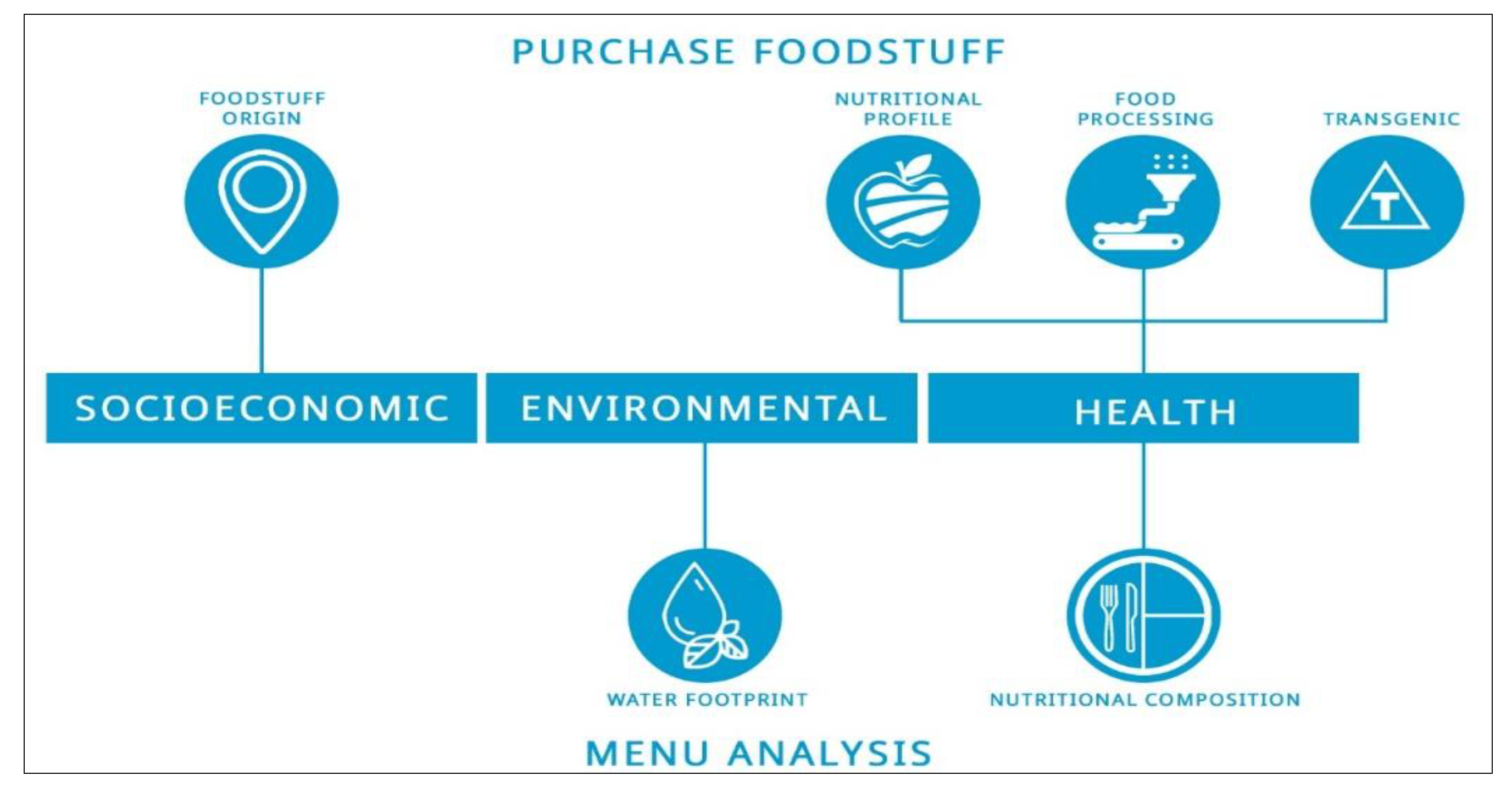
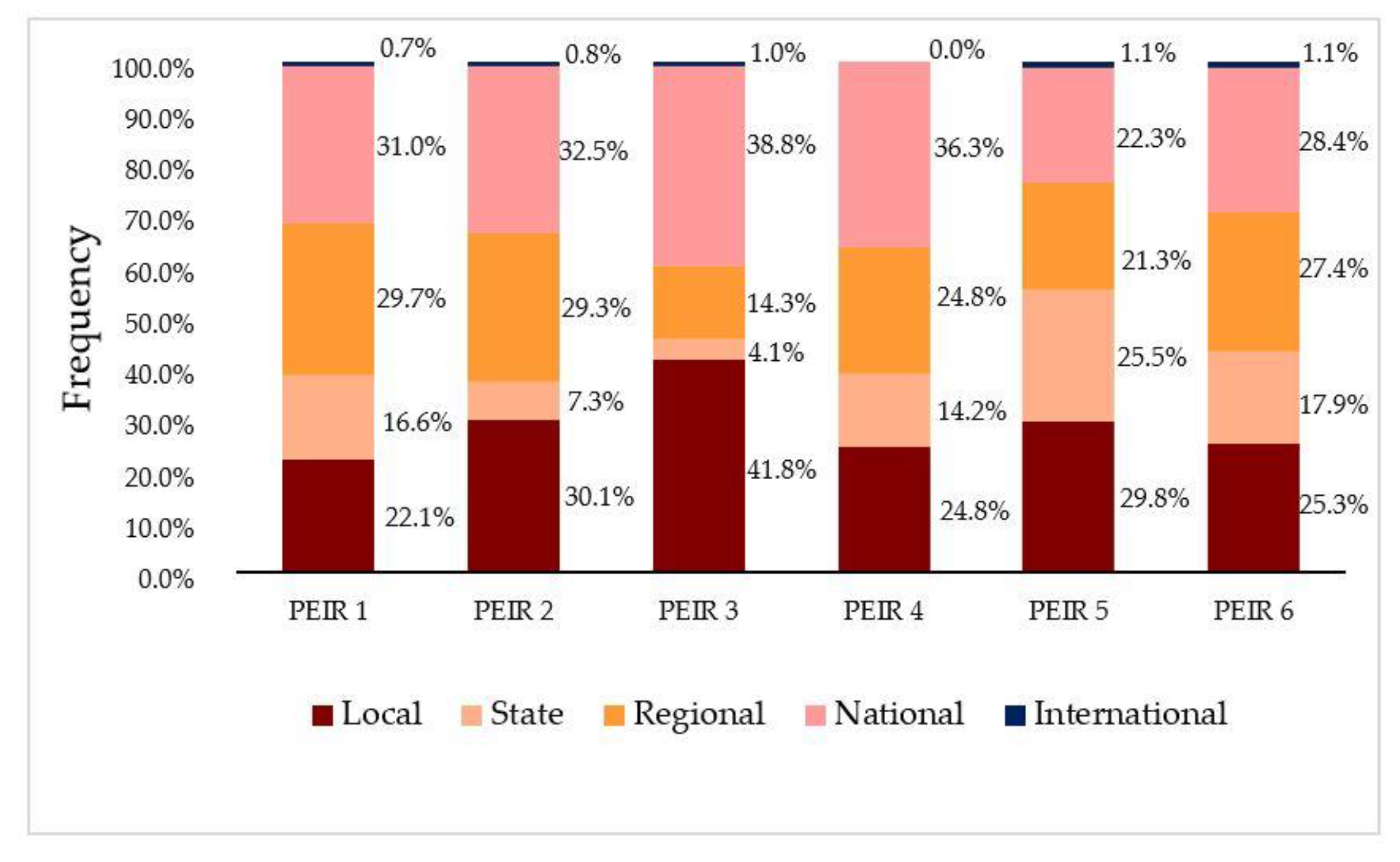
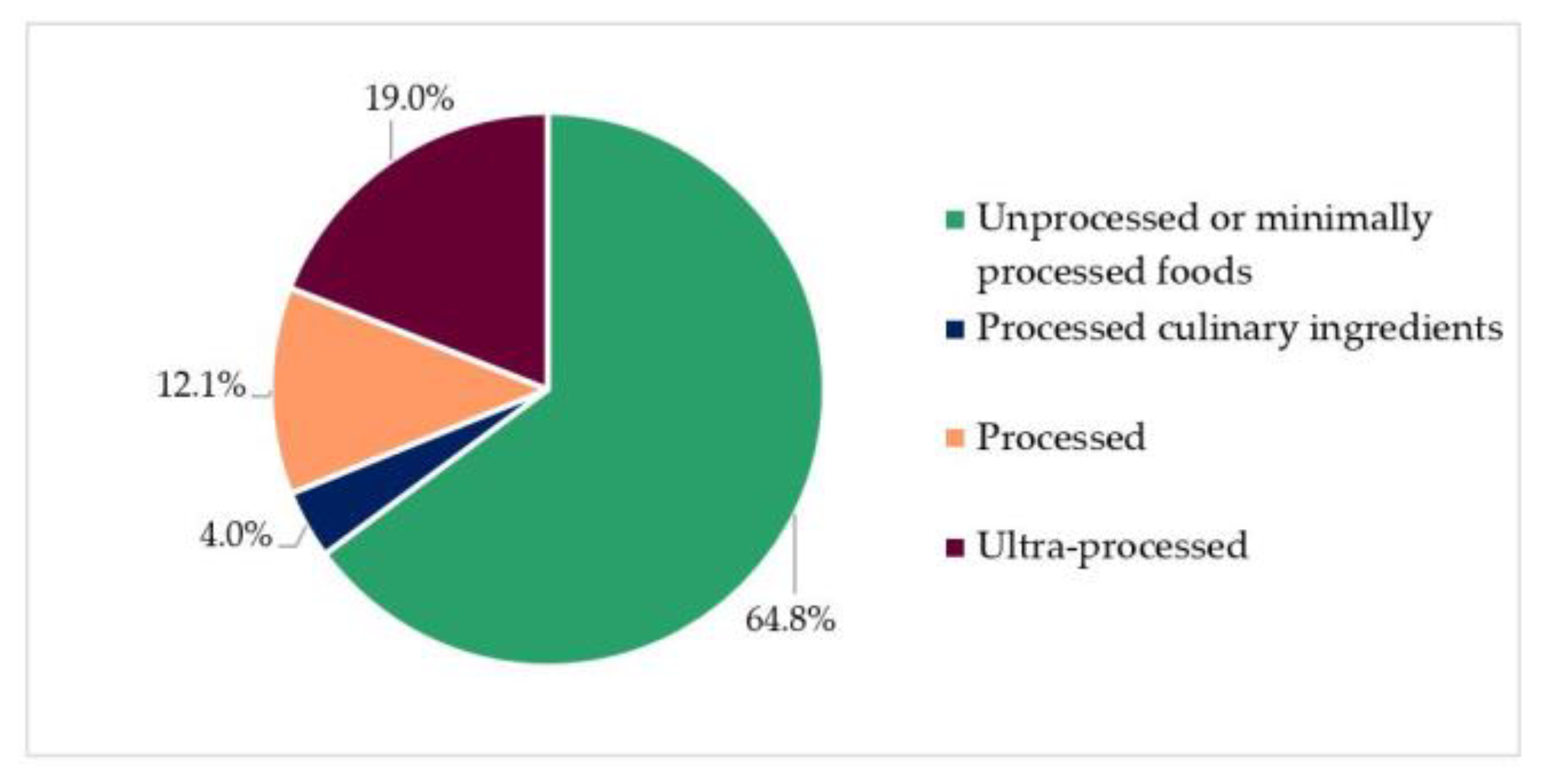
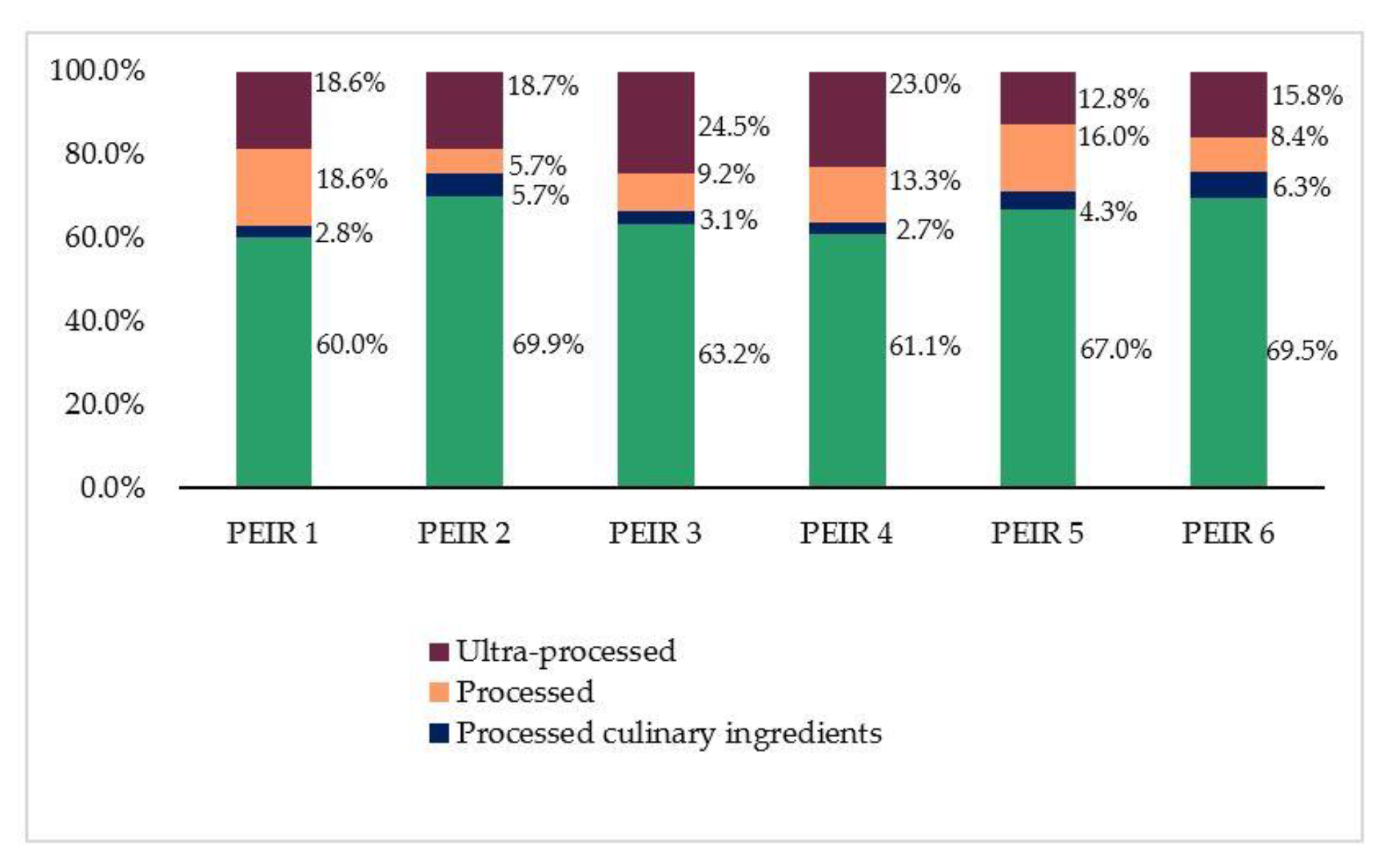
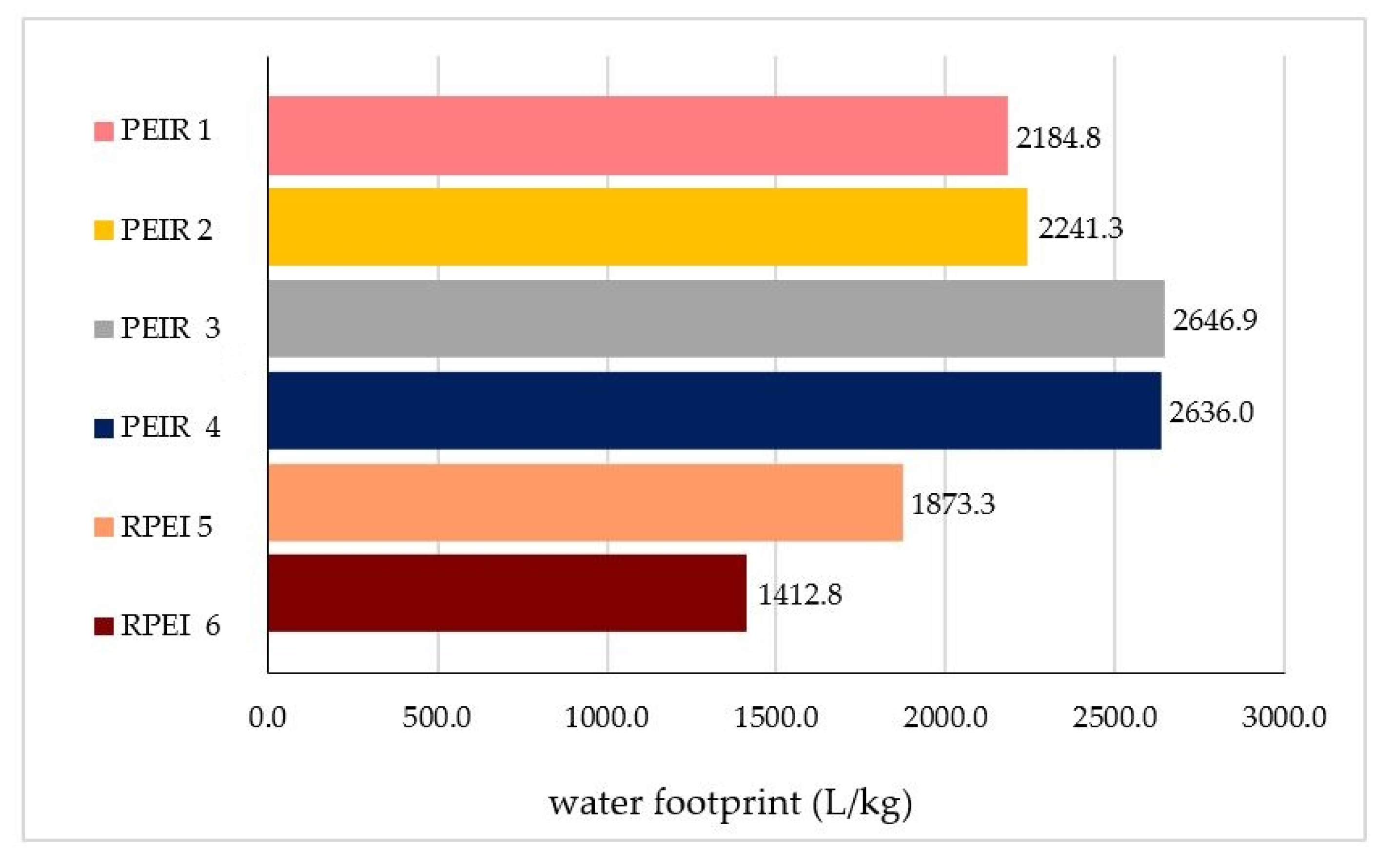
| ORIGIN | DEFINITION |
|---|---|
| Local | Up to ≈ 164 kilometers1 |
| State | Foodstuffs produced in the State of the RN2 |
| Regional | Foodstuffs produced in the Northeast Region2 |
| National | Produced in other regions of Brazil except the Northeast2 |
| International | Foodstuffs produced in other countries |
| Critical Nutrients/GMO | PEIR 1 % (n) | PEIR 2 % (n) | PEIR 3 % (n) | PEIR 4 % (n) | PEIR 5 % (n) | PEIR 6 % (n) | AVERAGE (SD) |
|---|---|---|---|---|---|---|---|
| Sodium | 63.0 (n = 34) | 53.3 (n = 16) | 63.6 (n = 21) | 68.3 (n = 28) | 55.6 (n = 15) | 60.9 (n = 14) | 60.8 (5.52) |
| Free sugars | 55.6 (n = 30) | 40.0 (n = 12) | 39.4 (n = 13) | 41.5 (n = 17) | 29.6 (n = 8) | 34.8 (n = 8) | 40.1 (8.71) |
| Other sweeteners | 11.1 (n = 6) | 26.7 (n = 8) | 12.1 (n = 4) | 14.6 (n = 6) | 11.1 (n = 3) | 21.7 (n = 5) | 16.2 (6.50) |
| Total fat | 44.4 (n = 24) | 63.3 (n = 19) | 48.5 (n = 16) | 48.8 (n = 20) | 25.9 (n = 7) | 30.4 (n = 7) | 43.6 (13.61) |
| Saturated fat | 42.6 (n = 23) | 66.7 (n = 20) | 60.6 (n = 20) | 41.5 (n = 17) | 22.2 (n = 6) | 47.8 (n = 11) | 46.9 (15.73) |
| Trans fat | 27.8 (n = 15) | 23.3 (n = 7) | 18.2 (n = 6) | 9.8 (n = 4) | 18.5 (n = 5) | 30.4 (n = 7) | 21.3 (7.49) |
| Transgenic | 5.6 (n = 6) | 9.2 (n = 8) | 13.7 (n = 10) | 10.2 (n = 8) | 7.4 (n = 4) | 8.8 (n = 6) | 9.2 (2.73) |
| Estimate Per Meal | PEIR 1 | PEIR 2 | PEIR 3 | PEIR 4 | PEIR 5 | PEIR 6 |
|---|---|---|---|---|---|---|
| Energy (Kcal) | 926.6 (77.3) * | 688.8 (110.0) | 975.0 (26.4) | 1040.9 (31.5) | 675.0 (22.7) | 701.4 (25.4) |
| Protein (g) | 58.5 (6.7) | 43.8 (8.4) | 66.3 (8.7) | 67.5 (2.4) | 37.0 (2.3) | 37.9 (1.4) |
| Carbohydrate (g) | 97.1 (7.8) | 81.8 (15.4) | 108.0 (4.3) | 106.6 (6.6) | 103.6 (4.0) | 104.0 (3.3) |
| Fat (g) | 34.6 (7.8) | 20.1 (11.7) | 30.5 (4.1) | 38.7 (1.3) | 12.5 (0.6) | 14.9 (2.0) |
| Saturated fat (g) | 10.8 (1.9) | 3.6 (0.5) | 9.7 (1.4) | 13.2 (0.5) | 3.6 (1.0) | 2.4 (0.6) |
| Monounsat. fat (g) | 13.8 (3.4) | 4.0 (0.5) | 12.0 (2.5) | 14.0 (0.7) | 3.4 (0.7) | 3.3 (0.8) |
| Polyunsaturat. fat (g) | 6.3 (2.7) | 3.3 (0.5) | 5.1 (0.2) | 7.2 (0.7) | 2.6 (0.4) | 6.4 (1.1) |
| Trans fat (g) | 0.5 (0.2) | 0.8 (0.7) | 0.6 (0.1) | 0.4 (0.0) | 0.3 (0.1) | 0.3 (0.1) |
| Free sugars (g) | 39.2 (2.3) | 7.8 (0.8) | 29.9 (2.7) | 47.6 (3.5) | 16.2 (0.1) | 12.0 (0.0) |
| Fiber (g) | 11.6 (0.1) | 9.9 (1.8) | 10.9 (1.0) | 12.1 (0.8) | 12.1 (0.7) | 12.6 (0.3) |
| Sodium (mg) | 1282.7 (267.5) | 535.7 (109.2) | 1244.7 (262.0) | 2234.7 (175.8) | 881.1 (155.7) | 1558.6 (28.2) |
© 2020 by the authors. Licensee MDPI, Basel, Switzerland. This article is an open access article distributed under the terms and conditions of the Creative Commons Attribution (CC BY) license (http://creativecommons.org/licenses/by/4.0/).
Share and Cite
Nogueira, J.P.; Hatjiathanassiadou, M.; de Souza, S.R.G.; Strasburg, V.J.; Rolim, P.M.; Seabra, L.M.J. Sustainable Perspective in Public Educational Institutions Restaurants: From Foodstuffs Purchase to Meal Offer. Sustainability 2020, 12, 4340. https://doi.org/10.3390/su12114340
Nogueira JP, Hatjiathanassiadou M, de Souza SRG, Strasburg VJ, Rolim PM, Seabra LMJ. Sustainable Perspective in Public Educational Institutions Restaurants: From Foodstuffs Purchase to Meal Offer. Sustainability. 2020; 12(11):4340. https://doi.org/10.3390/su12114340
Chicago/Turabian StyleNogueira, Josimara Pereira, Maria Hatjiathanassiadou, Sthephany Rayanne Gomes de Souza, Virgílio José Strasburg, Priscilla Moura Rolim, and Larissa Mont’Alverne Jucá Seabra. 2020. "Sustainable Perspective in Public Educational Institutions Restaurants: From Foodstuffs Purchase to Meal Offer" Sustainability 12, no. 11: 4340. https://doi.org/10.3390/su12114340
APA StyleNogueira, J. P., Hatjiathanassiadou, M., de Souza, S. R. G., Strasburg, V. J., Rolim, P. M., & Seabra, L. M. J. (2020). Sustainable Perspective in Public Educational Institutions Restaurants: From Foodstuffs Purchase to Meal Offer. Sustainability, 12(11), 4340. https://doi.org/10.3390/su12114340





